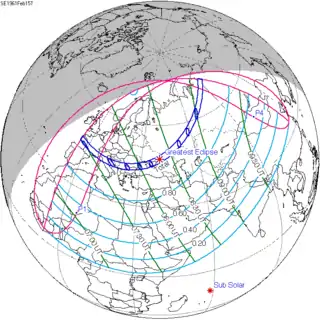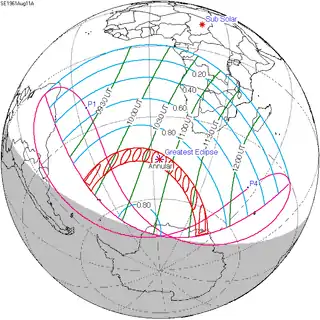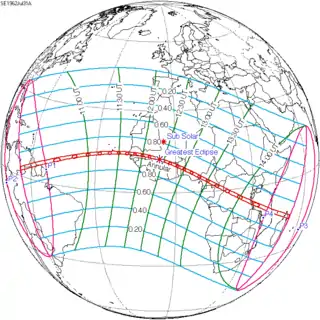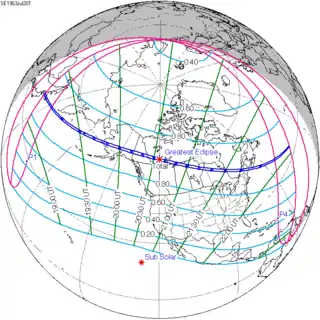| Solar eclipse of July 9, 1964 | |
|---|---|
 Map | |
| Type of eclipse | |
| Nature | Partial |
| Gamma | 1.3623 |
| Magnitude | 0.3221 |
| Maximum eclipse | |
| Coordinates | 67°36′N 172°54′W / 67.6°N 172.9°W |
| Times (UTC) | |
| Greatest eclipse | 11:17:53 |
| References | |
| Saros | 155 (3 of 71) |
| Catalog # (SE5000) | 9429 |
A partial solar eclipse occurred on July 9, 1964. A solar eclipse occurs when the Moon passes between Earth and the Sun, thereby totally or partly obscuring the image of the Sun for a viewer on Earth. A partial solar eclipse occurs in the polar regions of the Earth when the center of the Moon's shadow misses the Earth.
Related eclipses
Solar eclipses of 1961–1964
This eclipse is a member of a semester series. An eclipse in a semester series of solar eclipses repeats approximately every 177 days and 4 hours (a semester) at alternating nodes of the Moon's orbit.[1]
| Solar eclipse series sets from 1961–1964 | ||||||
|---|---|---|---|---|---|---|
| Descending node | Ascending node | |||||
| Saros | Map | Saros | Map | |||
| 120 |  1961 February 15 Total |
125 |  1961 August 11 Annular | |||
| 130 |  1962 February 5 Total |
135 |  1962 July 31 Annular | |||
| 140 |  1963 January 25 Annular |
145 |  1963 July 20 Total | |||
| 150 |  1964 January 14 Partial |
155 |  1964 July 9 Partial | |||
| Partial solar eclipses of June 10, 1964 and December 4, 1964 belong in the next lunar year set. | ||||||
References
- ↑ van Gent, R.H. "Solar- and Lunar-Eclipse Predictions from Antiquity to the Present". A Catalogue of Eclipse Cycles. Utrecht University. Retrieved 6 October 2018.
External links
- Earth visibility chart and eclipse statistics Eclipse Predictions by Fred Espenak, NASA/GSFC
This article is issued from Wikipedia. The text is licensed under Creative Commons - Attribution - Sharealike. Additional terms may apply for the media files.
.jpg.webp)

